御霊神社(鎌倉 坂ノ下)/ Goryo Shrine in Kamakura Sakanoshita
長谷駅近くの「鎌倉・江の島七福神」の「福禄寿」がいる鎌倉坂ノ下の「御霊神社」。/ (bilingual contents) “Goryo Shrine” where “Fukurokuju” of “Kamakura and Enoshima 7 lucky Gods” is enshrined, is located at Sakanoshita in Kamakura.
13時20分ごろ出かけ、帰宅15時40分の小旅行。
I went out around 13:20 and returned home for an excursion at 15:40.
「長谷駅」→「力餅家」→「虚空蔵堂」→「成就院」→「極楽寺」→「極楽寺駅」→「食パン専門店 Bread Code by recette 」→「御霊神社」→「長谷駅」小旅行。
Small Travel, “Hase Station” -> “Chikara-mochi-ya” -> “Kyokuzodo” -> “Jojuin” -> “Gokurakuji Temple” -> “Gokurakuji Station” -> “Bread shop, Bread Code by recette” -> “Goryo Shrine” -> “Hase Station” .
- 力餅家 (Chikara-Mochi-ya)
- 虚空蔵堂と成就院 (Kyokuzodo and Jojuin)
- 極楽寺 (Gokuraku temple)
- 食パン専門店 Bread Code by recette (Bread shop, Bread Code by recette)
■目次
- 鎌倉 坂ノ下 御霊神社とは
- 御霊神社と江ノ電
- 御霊神社の鳥居
- 「手水舎」での清め手順
- 霊神社と境内(多くの神社)
- 神社の正しい参り方
- 「鎌倉江ノ島七福神」の「福禄寿」(7月20日更新)
■鎌倉 坂ノ下 御霊神社とは
「力餅家」の角を曲がって直進すると、江ノ電の線路に出る。その線路の向こうに、「御霊神社」の鳥居がある。
Turn right at the “Chikara-mochi-ya” corner and go straight to the Enoden line. The torii gate of “Goryo Shrine” is located across the railroad track.
「御霊神社」の「御霊」の呼び方は、「ごりょう」、「ごれい」、「みたま」があるらしい。また、全国に多数あり、Wikiに掲載されている数で、関東地方14、中部地方1、近畿地方16、四国地方1となっている。
There are 3 pronunciations to call the temple which are “goryo”, “gorei”, or “mitama”. In addition, there are many the same name temple nationwide, and the number posted on the Wiki is 14 in Kanto region, 1 in Chubu region , 16 in Kinki region,1 in Shikoku region.
この「御霊神社」は、もともと関東平氏五家の始祖、すなわち鎌倉氏・梶原氏・村岡氏・長尾氏・大庭氏の5氏の霊を祀った神社だったそうだが、鎌倉権五郎景政が祭神となり権五郎神社と呼ばれるようになったそうです。
This “Goryo Shrine” was originally a ancestor of the five family members of the Kan-Heishi, namely, the five spirits of Kamakura, Kajiwara, Muraoka, Nagao, and Oba. After that, Kamakura Gongoro Kagemasa became a festival deity and the shrine was called it as Gongoro Shrine.
その逸話が、『「奥州後三年記」に、権五郎景政は十六歳にして源義家に従い、奥州後三年役に金沢の柵(秋田県)を攻めた。その時、鳥海三郎という者に右の眼に矢を射込まれたが、その矢を抜かず矢を放って相手を倒した。その後、陣に帰り「景政手負いたり」と大声してたおれた。そこに、三浦の平太為次が、土足のまま景政の眼に刺さった矢を抜こうと景政の面部に足をかけた。すると景政は「弓矢に当たって死するは武士の本望だ。なのに土足をもって面部を踏むとは何事ぞ」と刀をかまえてその無礼を叱咤した。為次はその無礼を謝まり、膝をついてその矢を抜いた。』というものらしいです。
The anecdote is that in “Oshu-go-Sannen-ki (Three-year story after Oshu,” Gongoro Kagemasa, at the age of sixteen, followed the Minamoto Yoshiie and attacked Kanazawa Fence (in Akita Prefecture) as the Oshu-go-Sannen battle. At that time, a person named Toriumi Saburo shot an arrow into Gongoro Kagemasa’s right eye, but he shot the arrow without pulling it and defeated the opponent. After that, he went back to the his team and shouted, “Kagemasa was injured”. Then, Teita Tametsugu living in Miura put his foot on the face of Kagemasa in order to pull out the arrow that stuck into Kagemasa’s eyes. Then, Kagemasa scolded Tametsugu’s rudeness with a sword, saying, “Samurai is willing to die by hitting an arrow. Why are you stepping on my face with your bare feet? ” Tametsugu apologized for his rudeness and struck his knees and pulled the arrow out.
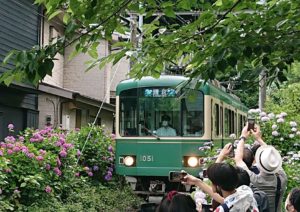
■御霊神社と江ノ電
さて、「極楽寺」のブログでも書きましたが、長谷駅と極楽寺駅の間に江ノ電唯一のトンネルがある。その片側の入り口が、この「御霊神社」のすぐ傍にある。なので、トンネルから出てくる江ノ電の写真を収めようと皆がこの線路の周辺に集まってくる。今は、紫陽花(あじさい)の時期なので、線路横の紫陽花と江ノ電を一緒に撮ることができます。
Well, as I wrote in the “Gokurakuji” blog, there is the only Enoden’s tunnel between Hase Station and Gokurakuji Station. The entrance on one side is right next to this “Goryo Shrine”. So everyone gathers around this track to get a photo of Enoden coming out of the tunnel. Now it’s time for hydrangea, so you can take photos of hydrangea and Enoden beside the track.
■御霊神社の鳥居
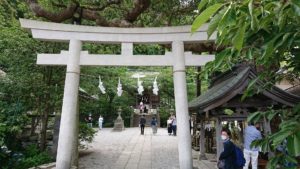
線路を越えると、目の前に鳥居があります。鳥居の向こうの右手に見える「手水舎(てみずや)」は、コロナ対策で使用不可でした。ということで、清めずに参拝です。
When you cross the railroad, there is a torii gate in front of you. You can look the “Temizuya (the place of wash hands to purify)” on the right hand beyond the torii. Unfortunately it was unusable due to countermeasures against corona virus. Let’s worship without purifying.

■「手水舎」での清め手順
本来であれば、以下が「手水舎」での清め手順ます。
Originally, the following is the procedure for purifying at the “Temizuya”.
- 右手で柄杓(ひしゃく)をもって水をとる
- 左手を洗って清め
- 柄杓を左手に持ち替え、右手を洗って清め
- 柄杓を右手に持ち替え、左手で水を受けて口をすすぐ
- そして、最後に柄杓を縦にして柄に水を流し清めます
- Take water with a ladle with your right hand.
- Wash your left hand and purify.
- Switch the ladle to your left hand, wash your right hand and purify.
- Hold the ladle in your right hand and receive water with your left hand to rinse your mouth.
- Finally, with the ladle vertical, pour water over the its handle to purify it.

■御霊神社と境内(多くの神社)
参道の左手の写真。朱の鳥居がある方が、「稲荷神社」。中央が、「秋葉神社」。右手は、石碑。
This is a photo on the left of the approach. The one with the red torii gate is “Inari Shrine”. The center is “Akiha Shrine”. On your right is a stone monument.

御神木は、タブノキ(Wiki)。樹高20m、推定樹齢350年だそうで、結構近くで見上げると立派である。全体を見上げきれないと言った方が正確かもしれないです。
The sacred tree is Tabuki. It seems that the tree height is over 20m and the estimated tree age is over 350 years. You cannot see the whole tree.
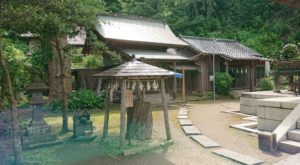
景正(影政)が、弓を立てたと言われる松。
The stump of pine tree is to say Kagemasa had his bow stand.
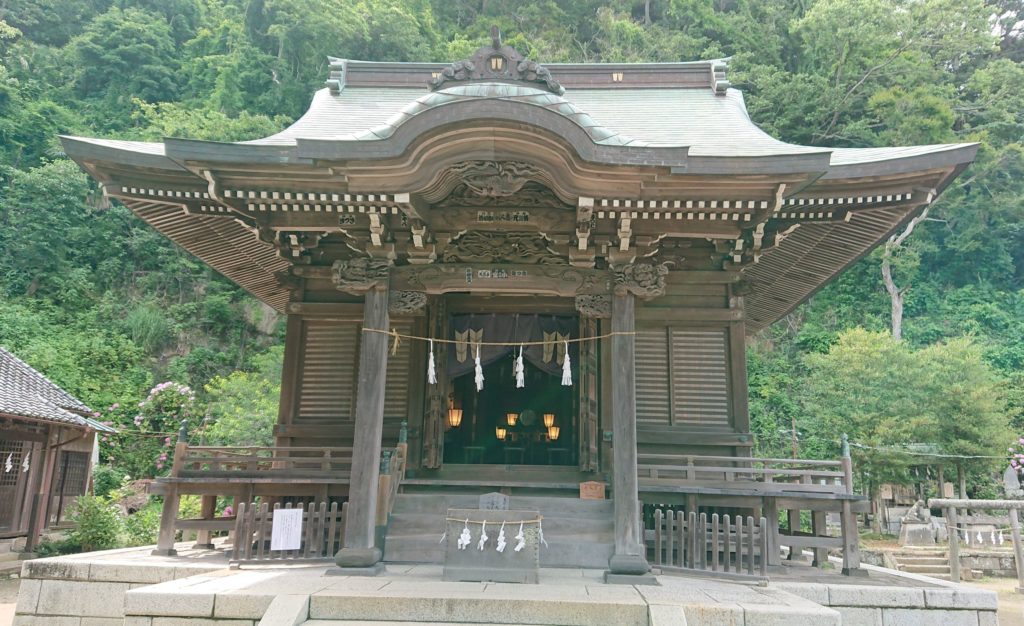
こちらが、「御霊神社」(鎌倉 権五郎神社)。奥には、鏡があります。この「御霊神社」には、鈴がありません。鈴を鳴らさず「二礼二拍手一礼」。
This is the “Goryo Shrine” (Kamakura Gongoro Shrine). There is a mirror in the house. There is no bell in this “Goryo Shrine”, so do “two bows, and two claps and one bow” without ringing.
■神社の正しい参り方
正しいお参りの仕方。ただし、場所に寄っては異なるのでご注意。
The right way to visit. However, please note that it depends on the location.
- 「手水舎(てみずや)」で清め
- 参道の端を歩いて本殿へ。(真ん中は神様の通り道)
- 拝殿前で立ち止まり一礼
- 鈴を鳴らす
- お賽銭
- 二礼二拍手し願い事
- 最後に一礼
- 下がって一礼
- Purify you at “Temizuya”. (like the above way)
- Walk along the shifted way of the center of the approach to go to the main shrine. (the center of the approach is God’s way)
- Stop in front of the front shrine
- Ring the bell.
- Throw money into the offering box.
- Wish after two bows and two claps
- Finally one bow.
- Step down and one bow down again.
「御霊神社」を出ると、江ノ電の線路沿いに歩いて、「長谷駅」に着きました。
When I left “Goryo Shrine”, I walked along the Enoden line and arrived at “Hase Station”.
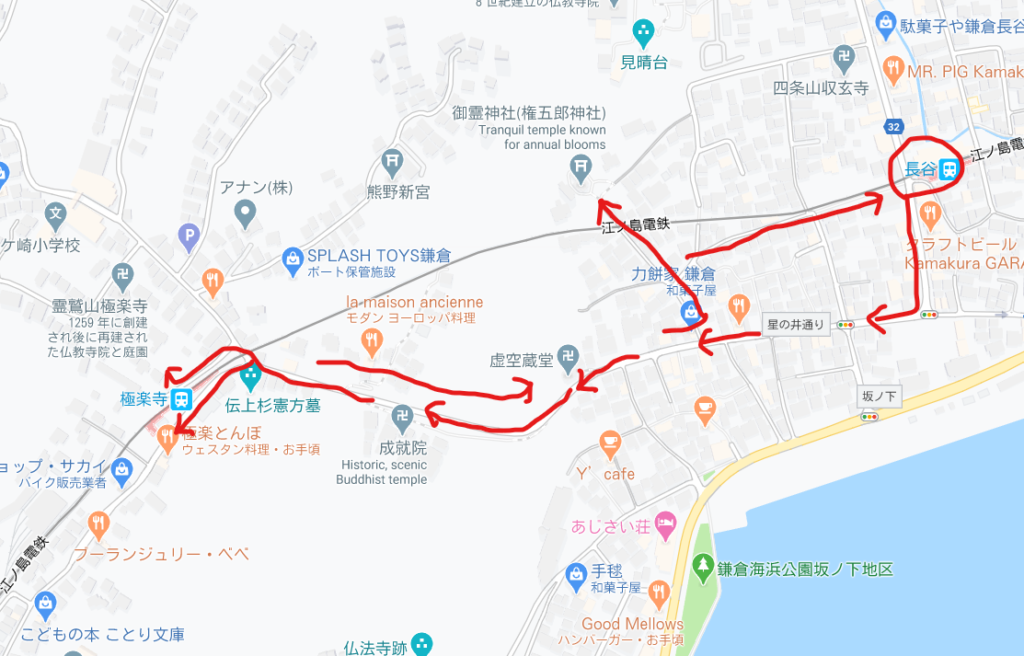
■「鎌倉江ノ島七福神」の「福禄寿」(7月20日更新)
7月20日、「鎌倉江ノ島七福神」の一人「福禄寿」様を見るために、ここ「御霊神社」に立ち寄りました。下図の上段の真ん中の神様。
On July 20, I stopped by “Goryo Shrine” again to see “Fukurokuju”, one of the “Kamakura Enoshima Seven Lucky Gods”. “Fukurokuju” God is in the middle of the upper part of the figure below.
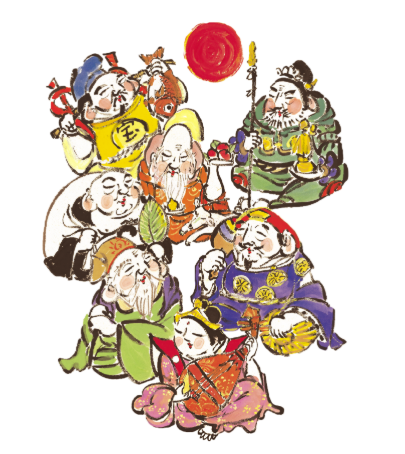
境内を良く見ると、「御霊神社宝蔵庫」という蔵があって、立て看板に「福禄寿」って書いてある。しかし、その倉は締まっているので、一旦諦めました。
If you look around the precincts, there is a warehouse called “Goryo Shrine Treasure House”, and the sign “Fukurokuju” is in front of it. However, the warehouse was closed, so I gave up at once.

その後、先回見なかった、境内の奥に行ってみました。
After that, I went to the the precincts which I hadn’t seen before.
すると、右手に、立派な銀杏(イチョウ)の木が2本ありました。「夫婦銀杏」というらしいです。銀杏は、雌株と雄株があるなと思っていると、立て看板に、「左が雄 右が雌」って書いてありました。
Then, on the right hand, there are two fine ginkgo trees. It is said to be a “couple ginkgo”. Ginkgo reminds me that there were female and male strains, and the signboard says, “Left is male, right is female”.
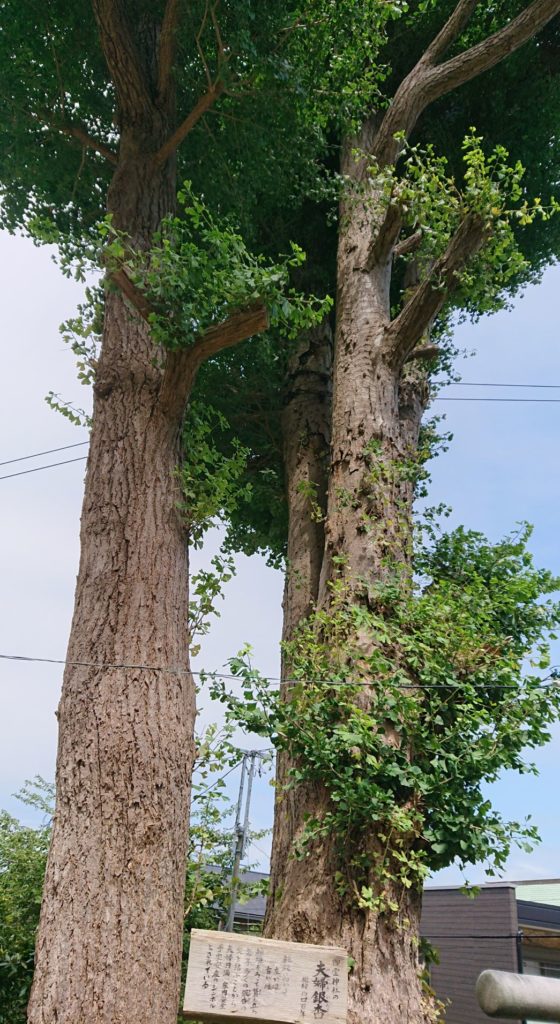
景正公が袂に入れたと言われている石。
A sphere stone that is said to have been put in his sleeve by Kagemasa.

讃岐、香川県の金刀比羅の分社、石上神社、八海山神社、御嶽山神社、三笠山神社などが並んでいます。
Sanuki, Konpira shrine branch of Kagawa prefecture, Ishigami Shrine, Hakkaiyama Shrine, Mitakeyama Shrine, Mikasayama Shrine, etc. are lined up.

本殿の右手奥の「御嶽神社」など、境内には、色々な神社が祀られているのですね。まさに、日本は、「八百万の神(やおよろずのかみ)」の国ですね。
Various shrines are enshrined in the precincts, such as the “Ontake Shrine” in the far right of the main shrine. Indeed, Japan is the country of the “8 million gods (there are a lot of Gods)”.
帰り際に、神社の方に、「福禄寿を見られるのはどういう時でしょうか」と聞いた所、「見たいですか?」と聞かれ、「見られるのなら見たいです」と言うと、「では、蔵を開けますので、拝観料100円を用意してお待ちください」と言われました。
When I was just go out the Goryo shrine, I asked shrine people “When would I be able to see Fukurokuju?”. After then I was asked “Do you want to see it?” and I answered “I want to see it if I can.” She said, “Then we will open the warehouse, so please prepare 100 yen for the admission fee and wait.”
そして蔵が開くと、「中にどうぞ」と案内されました。中に入ると、面がいくつも並び、「福禄寿」の立体プレートがありました。そのプレートのお腹のところは、多くの人たちが触ってきたために、つや光していました。
Then, when the warehouse opened, I was instructed, “Please inside.” Once inside, there were many masks lined up and there was a “Fukurokuju” three-dimensional plate. The stomach of the plate was shiny because many people have touched it.

「福禄寿」は、Wikiによると、「幸福(現代日本語でいう漠然とした幸福全般のことではなく血のつながった実の子に恵まれること)、封禄(財産のこと)、長寿(単なる長生きではなく健康を伴う長寿)の三徳を具現化したものである」と書かれているので、まさに、無事実子が身ごもることを祈願してのお参りです。
According to the Wiki, “Fukurokuju” means “happiness (not to be vague general happiness in modern Japanese, to be blessed with a real child with blood), Rokuroku (fortune), longevity (simply It embodies the three virtues of longevity with good health (not only longevity)”, so prayer hope for getting the true child by praying.
心残りだった、「福禄寿」に会えてすっきりした気分になれました。
I felt refreshed to see “Fukurokuju,” which was a regret before.



この記事へのコメント